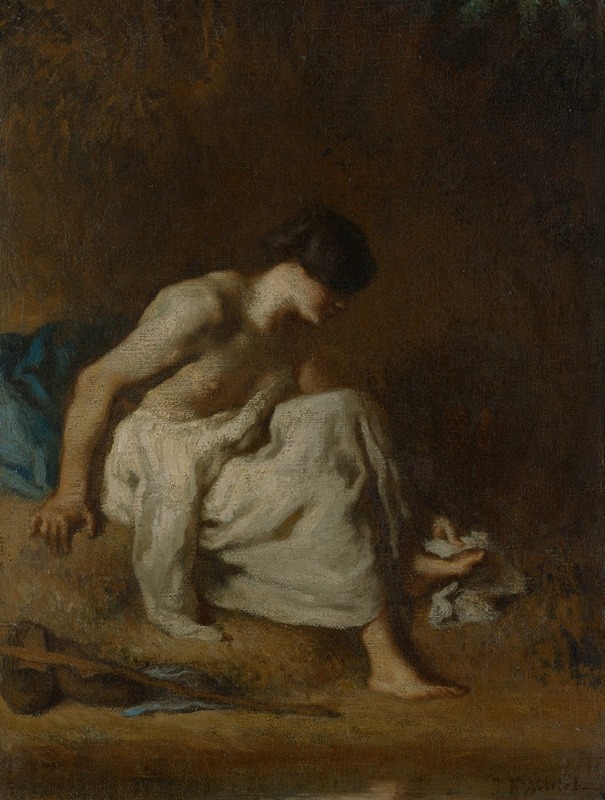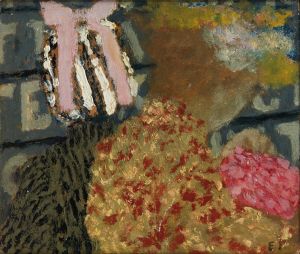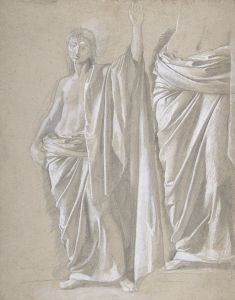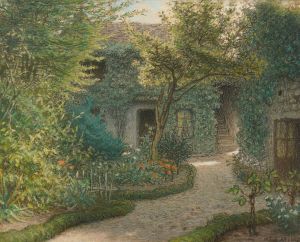
The Bather
A hand-painted replica of Jean-François Millet’s masterpiece The Bather, meticulously crafted by professional artists to capture the true essence of the original. Each piece is created with museum-quality canvas and rare mineral pigments, carefully painted by experienced artists with delicate brushstrokes and rich, layered colors to perfectly recreate the texture of the original artwork. Unlike machine-printed reproductions, this hand-painted version brings the painting to life, infused with the artist’s emotions and skill in every stroke. Whether for personal collection or home decoration, it instantly elevates the artistic atmosphere of any space.
Jean-François Millet, a prominent French painter and one of the founders of the Barbizon School, is renowned for his depictions of peasant life and rural landscapes. One of his lesser-known works, "The Bather," exemplifies his ability to capture the human form with sensitivity and a deep understanding of the natural world. Although not as famous as some of his other works like "The Gleaners" or "The Angelus," "The Bather" provides insight into Millet's artistic style and thematic interests.
"The Bather" was created during a period when Millet was deeply engaged with the rural environment and the people who inhabited it. His work often reflects a profound respect for the dignity and labor of peasants, and while "The Bather" does not directly depict agricultural labor, it shares the same attention to the human figure and its relationship with nature. This painting is a testament to Millet's skill in rendering the human body with a sense of realism and grace.
In "The Bather," Millet employs a muted color palette, typical of his style, which emphasizes the natural tones of the landscape and the figure. The composition is balanced, with the bather positioned in a way that draws the viewer's eye across the canvas, inviting contemplation of the scene. Millet's brushwork is both delicate and expressive, capturing the texture of the skin and the surrounding environment with subtlety.
Millet's approach to the human figure in "The Bather" is characterized by a sense of solidity and presence. The figure is depicted with a naturalistic attention to anatomy, yet there is also an idealized quality that suggests a timeless connection between humanity and nature. This duality is a hallmark of Millet's work, where the everyday and the eternal coexist harmoniously.
The context of "The Bather" within Millet's oeuvre is significant. During the mid-19th century, when this painting was likely created, there was a growing interest in realism and the depiction of contemporary life. Millet was at the forefront of this movement, and his work often challenged the conventions of academic art by focusing on subjects that were considered mundane or unworthy of high art. "The Bather," while not overtly political, can be seen as part of this broader trend towards realism and the democratization of art.
Millet's influence on later artists cannot be overstated. His work paved the way for future generations of painters who sought to capture the realities of everyday life. "The Bather," with its focus on the human form and its integration into the natural world, reflects the themes that would continue to resonate in the works of artists such as Vincent van Gogh and Claude Monet.
In summary, "The Bather" by Jean-François Millet is a compelling example of the artist's ability to blend realism with a deep appreciation for the human condition. Through his careful attention to detail and composition, Millet creates a work that is both intimate and universal, inviting viewers to reflect on the enduring relationship between humanity and nature.


















